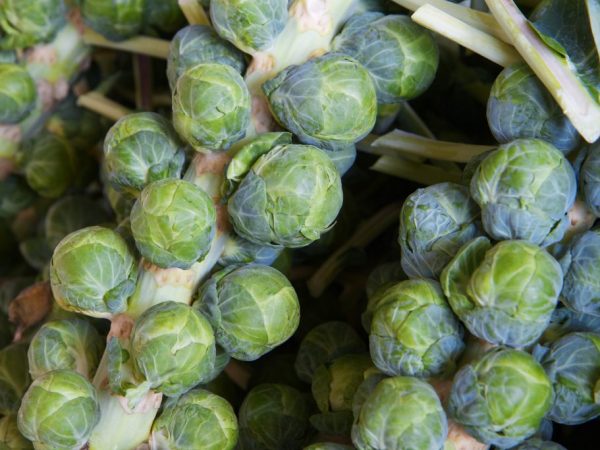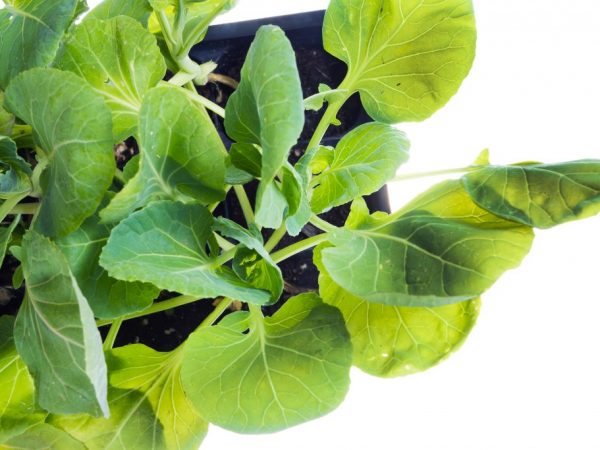Description of small cabbage
Little cabbage is a type of Brussels sprouts. It is characterized by small fruits that resemble walnuts in appearance. It contains a large amount of useful trace elements that have a positive effect on human health.

Description of small cabbage
Plant characteristic
Small Brussels sprouts are called for a reason. The name comes from the country of creation - Brussels. Small cabbage has the ability to cross-pollinate. The plant is biennial. Its appearance differs from that of other varieties (white cabbage, cauliflower or broccoli).
The yield of the variety is average: about 200 kg of green heads of cabbage are harvested from 1 hectare.
Description of the plant
In the first year of germination, the plant is characterized by the presence of thick cylindrical heads of cabbage. Their height reaches 60 cm, and sometimes reaches 100 cm. The leaves are small, weakly lyre-shaped. Petioles reach a height of 30-35 cm. The color of small leaves is light green. They are completely covered with a waxy coating. The edges of the leaves can be straight or wavy. Small round heads of cabbage form in the deciduous sinuses. On 1 plant, their number can reach 30 pcs.
In the second year of life, small cabbage develops shoots and forks (inflorescences). Medium forks with a lot of leaves.
In the second year, the plant blooms and produces seeds. Flowers of a yellow hue are collected in a small brush.
Features of the fetus
The small fruit contains a large number of seeds and has a pod-like appearance. The shape of the fruit is round with a small oval at the base. The diameter of one seed reaches 2 mm. The shape of the head is spherical. The surface is smooth to the touch. 1 g of fruit contains about 250 seeds. They are planted within 5-6 years from the date of collection.
According to the description, the taste of cabbage is rich and pleasant. There are notes of sweetness and a little piquant bitterness. It is recommended to be consumed fresh or used for making salads. Small balls are often used to decorate main courses.
Landing
Soil preparation
Small green cabbage is grown only in fertile soils. For this, the land is prepared in the fall. Before plowing the site, organic fertilizers (cow dung, humus or peat) are applied to the ground. The optimal volume is 2 buckets of 10 liters per 1 sq. m. In the spring, the soil is loosened with a hoe. Weeding depth should be at least 5-8 cm.
In the process of loosening the soil, you can use superphosphate fertilizers. The recommended volume is about 150 g per 1 sq. m. To make small heads of cabbage form faster, 200 g of bone meal is added for each square meter. Planting is allowed only in early May, when the risk of frost is reduced.
Planting seeds

Seedlings need to be thinned out
To plant seeds, a separate large container is selected. It is best to plant seeds in early March. Before planting, they do not need to be disinfected or treated with growth stimulants. The planting depth in the container should be no more than 1.2 cm.The distance between the seeds of the heads of small cabbage is about 5 cm.
Containers must be covered with plastic wrap. This significantly speeds up the process of emergence of the first shoots and reduces the risk of disease. After the start of germination, you can remove the covering material, and then thin out the plants. This will allow the root system to form properly for safe outdoor planting.
Transplanting
Seedlings are transplanted into open ground after the green plant reaches a height of 20 cm. The best adhesion of the plant to the ground occurs if the area is watered with a little water in advance. When planting seedlings in moist soil, the roots quickly attach to the ground.
Planting is carried out so that the lower green leaves are above the ground. The optimal distance between the bushes is about 1 m. This distance allows the plant to form without harm to itself or neighboring bushes. It is important that they do not overshadow each other.
Care advice
Small round cabbage needs careful grooming. You should remember about high-quality and timely watering. Preference is given to drip irrigation: this way the root part is moistened, which is ideal for this plant. The bushes should be watered no more than once a week. This is enough to moisten the soil.
After each watering, weeds are removed and the topsoil is removed. This is necessary for the required amount of oxygen, moisture and nutrients to enter the soil after the subcortex. Weeding depth should be no more than 6 cm so as not to disturb the root system.
Fertilizer
Top dressing is carried out in several stages:
- The first top dressing is applied 10 days after planting the plant in open ground. Preference is given to mineral fertilizers: per 1 sq. m 10 g of ammonium nitrate, 10 g of superphosphate, 10 g of potassium nitrate are introduced.
- During the second feeding, from the beginning of the head formation, 10 g of ammonium nitrate, 9 g of potassium chloride are used. Fertilizers are applied at a distance of 10 cm from the bush.
Instead of mineral fertilizers during the second feeding, it is permissible to use organic matter. Chicken droppings and humus are ideal for this. 100 g of each substance is diluted in 10 liters of warm water and about 2 liters of tincture is poured under each bush.
Diseases and pests
Small cabbage heads are characterized by a strong immune system. They are rarely exposed to diseases, but they are susceptible to the invasion of parasites.
So that the plants are not affected by a flea or beetles, they are sprayed with special chemicals. For example, Bordeaux liquid or colloidal salt. About 30 mg of the drug is diluted in 10 liters of warm water, spraying is carried out every 10-12 days.
If the round cabbage has been infested with aphids, spraying with copper preparations (Oxyhom or Epin) is carried out. To do this, dilute 10 mg of the drug in 5 liters of water, spray the bushes every 7-10 days.
Conclusion
The little green cabbage is called Brussels sprouts. It contains the maximum amount of nutrients compared to other varieties, which is why it is ideal for dietary or medical nutrition.


